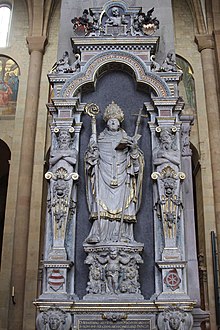Sebastian von Heusenstamm
Sebastian von Heusenstamm (born March 16, 1508 in Frankfurt am Main , † March 18, 1555 in Eltville ), from the house of the Lords of Heusenstamm , was Elector and Archbishop of Mainz and thus Arch Chancellor of the Holy Roman Empire .
origin
He was the son of the knight Martin I. von Heusenstamm († 1540), mayor of the city of Frankfurt am Main and his wife Elisabeth born. Brendel von Homburg († 1508). The grave slab of the mother, with her ancestral coat of arms and a. from the family of the Palatinate Lords von Zeiskam , is walled in in the area of the former Patershausen monastery .
Life
Sebastian's term of office fell during the troubled times after the Reformation , the upheavals of which also and particularly affected the important archbishopric of Mainz. Even before his election as Archbishop, Sebastian was as a cathedral scholaster a respected man in the Mainz cathedral chapter . This also made him a favorite to succeed Cardinal Albrecht of Brandenburg as Archbishop of Mainz. The cathedral chapter defied Charles V , who absolutely wanted the bishop of Augsburg , Cardinal Otto Truchseß von Waldburg , as the new archbishop, since he could be sure that he would remain with Catholicism in the important archbishopric.
On October 20, 1545 Sebastian was elected as the new archbishop. Sebastian had previously been suspicious of Catholic princes, as his supporters also included the Protestant Landgrave Philip of Hesse . But there was apparently little doubt about Sebastian's faithfulness, even the Pope confirmed the archbishop a little later in office. On May 2nd, 1546, Sebastian was ordained bishop by Melchior Zobel von Giebelstadt , Bishop of Würzburg.
The Archbishop of Mainz was Archbishop of the Reich and one of the seven electors , thus one of the most important imperial princes and politicians. The rather apolitical Sebastian therefore faced difficult political questions immediately after taking office. First of all, it was important to get out of the so-called Schmalkaldic War undamaged , which was not entirely successful.
The pushing back or demarcation from Protestantism, which the Council of Trent dealt with at the same time, was also politically highly complicated . Since the final clarification of the questions was delayed too long, Charles V ordered the Augsburg interim in 1548 . In addition to a few concessions to the Protestants (marriage of priests), an extended visitation activity by the Catholic bishops was intended to reduce the influence of Protestantism. The visitation protocols prepared by the Mainz Auxiliary Bishop Michael Helding , who was largely entrusted with these tasks , are excellent testimony to the state of the church landscape at that time.
The reformation in the archbishopric had fragmented it, which made a reform necessary, which Archbishop Sebastian introduced on November 19, 1548 with a synod to which all clerical dignitaries (including those who had meanwhile become Protestant) were invited. The aim of the synod was an internal church reform. In the end, liturgical books and a new catechism were published. In 1549 Sebastian held a provincial synod with which he wanted to extend the results of the synod to the rest of his metropolitan association. Here, too, the aim was not confrontation, but strengthening and reform from within.
To finally clarify the relationship between Protestants and Catholics, the Council of Trent, which the Pope had convened after an interruption in 1551, was again supposed to serve. In addition to Archbishop and Elector Sebastian, the Electors of Cologne and Trier also took part in this second session . There Sebastian made important suggestions about theology and the church, but behaved diplomatically when it came to political questions. In this way he secured the benevolence of the Pope, who even considered giving Sebastian the cardinal dignity . But in 1552 new unrest broke out in Germany, including the so-called Markgräflerkrieg . Sebastian and the other electors rushed back to their provinces. After the defeat of the emperor in 1552 , the danger seemed over, but the Margrave Albrecht Alcibiades of Brandenburg-Kulmbach began to wage war on his own. In 1552 he invaded Mainz and devastated the city.
Since Sebastian now had to see that the emperor could not protect the ecclesiastical territories either, he advocated an imperial religious peace that should at least preserve the remaining ecclesiastical pens . However , he never saw the signing of such a treaty, the Augsburg Religious Peace . On March 18, 1555 , the "man most distinguished by his spirit and dexterity in business" (epitaph) died and was buried in the memorial chapel of Mainz Cathedral . An elaborate funerary monument is dedicated to him in the cathedral.
His nephew, cathedral capitular Wolfgang von Heusenstamm († 1594), also owns a valuable epitaph in Mainz cathedral.
literature
- Andreas Ludwig Veit: Church and church reform in the Archdiocese of Mainz in the age of religious schism and the beginning Tridentine Reformation (1517-1618). Herder, Freiburg 1920 (see also the critical review by Karl Schornbaum ).
- Rolf Decot : Religious Peace and Church Reform . The Mainz Elector Sebastian von Heusenstamm 1545–1555 (= publications of the Institute for European History Mainz , Volume 100). Steiner, Wiesbaden 1980, ISBN 3-515-03307-6 .
- Friedhelm Jürgensmeier: Sebastian von Heusenstamm. In: New German Biography (NDB). Volume 24, Duncker & Humblot, Berlin 2010, ISBN 978-3-428-11205-0 , p. 108 f. ( Digitized version ).
See also
Web links
Individual evidence
| predecessor | Office | successor |
|---|---|---|
| Albrecht of Brandenburg |
Elector-Archbishop of Mainz 1545–1555 |
Daniel Brendel from Homburg |
| personal data | |
|---|---|
| SURNAME | Heusenstamm, Sebastian von |
| BRIEF DESCRIPTION | Archbishop of Mainz, Imperial Arch Chancellor |
| DATE OF BIRTH | March 16, 1508 |
| PLACE OF BIRTH | Frankfurt am Main |
| DATE OF DEATH | March 18, 1555 |
| Place of death | Eltville |



